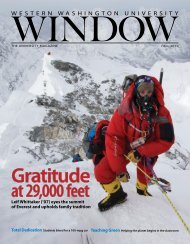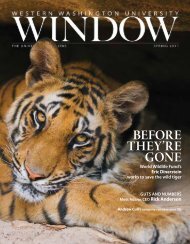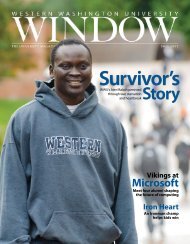WINDOW
Pushing - WINDOW - The magazine for WWU
Pushing - WINDOW - The magazine for WWU
- No tags were found...
You also want an ePaper? Increase the reach of your titles
YUMPU automatically turns print PDFs into web optimized ePapers that Google loves.
“It was a constant reminder of our<br />
connection to that event and the experiences<br />
we had in Alabama,” says Rand<br />
Jimerson, who is also director of the<br />
Archives & Records<br />
Management program<br />
at Western.<br />
As an archivist,<br />
Jimerson says<br />
he recognizes his<br />
father’s decision to<br />
pick up the glass<br />
shards “was part of<br />
his desire to document<br />
and have evidence of<br />
that atrocity.” The family<br />
carefully “archived”<br />
the glass over the years,<br />
always keeping it in a<br />
place of prominence on a<br />
Jim Jimerson urged other<br />
white ministers to join<br />
him in expressing concern<br />
about the tragedy, but not<br />
one would.<br />
hutch in the dining room. In 2002, Melva<br />
Jimerson donated part of the stained glass<br />
to the Birmingham Civil Rights Institute.<br />
The rest remained in the family’s care.<br />
Then a 2012 speech made by<br />
President Obama at the groundbreaking<br />
of the Smithsonian’s National Museum<br />
of African American History & Culture<br />
made Rand Jimerson think it was time to<br />
share their piece of history. In his speech,<br />
the president said he would like his<br />
daughters to see artifacts from the civil<br />
rights era, such as “shards of glass” from<br />
the church bombing.<br />
“This was valuable evidence,” Rand<br />
Jimerson says, “important for people to<br />
see and appreciate and understand those<br />
events.”<br />
Rand Jimerson and three of his four<br />
siblings went to Washington, D.C., in<br />
September to donate the glass,<br />
bringing its story full circle. The story<br />
of the Jimerson family will come full<br />
circle next year when Rand will release<br />
“Shattered Glass in<br />
Birmingham: My<br />
Family’s Fight for Civil<br />
Rights, 1961-1964”<br />
(LSU Press).<br />
Life in the South<br />
Told from<br />
14-year-old Rand’s<br />
point of view, this<br />
memoir sheds light on the civil rights<br />
movement from the point of view of the<br />
majority’s minority: whites in the South<br />
who supported civil rights.<br />
Rand Jimerson says his father was<br />
the only white person to attend every<br />
one of the funerals of the girls who died<br />
in the bombings and the two African-<br />
American boys who died in the violence<br />
on the same day as the blast. In the weeks<br />
following, the family received numerous<br />
anonymous death threats and harassing<br />
phone calls.<br />
As a teenager, a time in life when<br />
it feels so important to fit in, Rand<br />
Jimerson kept his opinions on racial<br />
equality to himself.<br />
“I had adopted, I just recently realized,<br />
a sort of ‘don’t ask, don’t tell’ policy<br />
where I wouldn’t ask any of my classmates<br />
or friends what they thought about<br />
race relations,” he says, “because if they<br />
gave the answer I expected most of them<br />
to give, it would be difficult for me to<br />
continue a friendship.”<br />
Once, he couldn’t help but speak out<br />
1963 Jimerson family photo: Rand Jimerson (left) with his siblings Ann, Paul and Sue. Mark, the baby, is in<br />
Ann's lap. Above, left: Jimerson's forthcoming memoir from LSU Press.<br />
when his teacher said all civil rights activists<br />
were communists. Rand Jimerson<br />
says his teacher turned purple in the face<br />
hearing Rand’s defense of the activists,<br />
which, of course, included his father.<br />
A lifetime of social justice<br />
Steeped in the history-making events<br />
in the South as a teen, Jimerson pursued<br />
a career in academics, first focusing on<br />
history and then taking an interest in<br />
archival work. He began to see a thread<br />
between his work and his belief in social<br />
justice he had inherited from his parents.<br />
Melva Brooks Jimerson<br />
often said the twisted<br />
metal was a reminder of<br />
the “twisted minds” that<br />
could feel such hate and<br />
conceive such a horrific act.<br />
Western’s Archives &<br />
Records Management<br />
Graduate Program<br />
Established in: 1972<br />
Programs offered: Two-year<br />
master’s degree, one-year postgraduate<br />
certificate.<br />
Number of students: 30<br />
Number of alumni: about 170<br />
Curriculum: Emphasizes<br />
the disciplines of archives<br />
and records management in<br />
documenting and preserving<br />
essential evidence of modern<br />
organizations and individuals.<br />
As Jimerson explains, archival<br />
documents sometimes provide<br />
accountability that can serve as<br />
a basis for social justice.<br />
Graduates are: Working<br />
in government, academia,<br />
museums, historical societies,<br />
religious organizations and<br />
private industry.<br />
More:<br />
www.wwu.edu/history/archivalstudies/<br />
“As I became more and more engaged<br />
as an archivist,” Jimerson says, “I realized<br />
the work I was doing was helping people<br />
with their immediate needs.”<br />
Jimerson explains that archival<br />
documents have supported social justice<br />
causes throughout the world, such as the<br />
fight against South African apartheid,<br />
documenting the brutality of the Khmer<br />
Rouge in Cambodia, and restoring valuables<br />
to Jewish families whose belongings<br />
were stolen by the Nazis. Archives’ role<br />
on a smaller, yet no less important scale,<br />
has helped people to prove their birth<br />
date in order to receive Social Security,<br />
pension and insurance benefits.<br />
“That [idea has] become an important<br />
part of how I talk to grad students,”<br />
Jimerson says. He sees it as a distinguishing<br />
feature of Western’s Archives &<br />
Records Management program.<br />
Revealing the emotional truth<br />
Jimerson has written extensively<br />
about archivists’ role in social justice,<br />
including a book titled, “Archives Power:<br />
Memory, Accountability, and Social<br />
Justice.” (Society of American Archivists).<br />
But in his most recent project, “Shattered<br />
Glass,” he takes on the role of memoirist.<br />
Jimerson wrestled with how to tell<br />
his family’s story, and he finally settled<br />
on a memoir told from his viewpoint as a<br />
teenager. His father has passed away and<br />
Photo by Adelle M. Banks/<br />
Religion News Service<br />
Donation: Kinshasha Holman Conwill, left, deputy director of the National Museum of African American History<br />
and Culture, shakes hands with Ann Jimerson at a ceremony to receive the Jimersons' donation of broken<br />
stained glass from the 1963 bombing of the Sixteenth Baptist Church in Birmingham, Ala. Jimerson siblings<br />
Randall, Mark and Sue look on.<br />
his mother’s health is frail, but each sibling<br />
contributed to the epilogue accounts<br />
of how those years shaped their lives.<br />
Though the memoir is a departure<br />
from his academic writing, Jimerson<br />
still used research in compiling his story,<br />
traveling to Alabama for documents from<br />
his father’s work to fill in details he didn’t<br />
know. He also drew upon interviews he<br />
conducted with his father years ago.<br />
“I’m a historian, and I’m used to doing<br />
research and historical analysis, but I<br />
tried not to do very much of that in the<br />
book’s language,” Jimerson explains.<br />
The academic in him wonders if some<br />
may take issue with his presentation of<br />
the story’s facts. For example, in the book<br />
prologue Jimerson recounts the day of<br />
the bombing from his father’s point of<br />
view, relying more on a son’s inference<br />
than a scholar’s documentation.<br />
But Jimerson said this book is about<br />
more than hard facts: “I think it gets at<br />
what I think is the emotional truth of the<br />
experience, rather than the literal truth of<br />
direct quotations that historians are limited<br />
by,” Jimerson says. “As a historian, I follow<br />
those rules. But as a memoirist, I took<br />
some liberties to engage what I think of as<br />
the emotional truth of the experiences.”<br />
Hilary Parker (’95, Journalism) is a freelance<br />
writer based in Bellingham. This is her<br />
first story for Window magazine.<br />
20 <strong>WINDOW</strong> • Fall/Winter 2013 • Western Washington University www.wwu.edu/window 21








